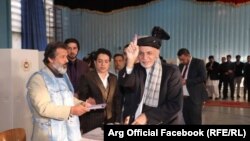KABUL -- Afghans started voting early on October 20 in parliamentary elections that are testing the government’s ability to provide security across the country.
Originally scheduled for 2015, the vote was delayed for three years amid disputes over electoral reforms and because of the instability following NATO’s handover of security responsibilities to Afghan forces at the end of 2014.
The Afghan government wants to show it can conduct the vote safely and transparently despite ongoing fighting between government forces and militants in at least 20 of Afghanistan’s 34 provinces.
It is deploying more than 50,000 Afghan police and troops to protect nearly 19,000 polling stations across the country.
Candidates, campaign rallies, and senior security officials have been targeted in deadly attacks by Taliban and Islamic State (IS) extremists – including suicide attacks, motorcycle bombings, and drive-by shootings.
During the three-week campaign period, two candidates and 34 civilians were killed in militant attacks.
Eight other candidates were killed by militants during the run-up to campaigning, and the fate of two abducted candidates remains unknown.
Afghanistan’s Independent Election Commission decided on October 19to delay voting by one week in the southern province of Kandahar because of the killing of the provincial police chief, General Abdul Raziq.
Election Commission spokesman Hafizullah Hashimi said the people of Kandahar were “morally not ready to vote” so soon after Raziq and the provincial intelligence chief were killed on October 18 by a rogue bodyguard of the provincial governor.
Elections also won’t be held on October 20 in 10 Afghan districts in different parts of the country that are under Taliban control.
They include five districts in the Taliban stronghold of Helmand Province, two in the northeastern province of Badakhshan, one in the southern province of Zabul, and districts in the northern provinces of Baghlan and Sar-e Pul.
Voting also has been postponed indefinitely in Ghazni Province amid a dispute over how to map out voting precincts to achieve more balanced ethnic representation.
In Afghanistan’s last parliamentary election, held in 2010, candidates from the ethnic Hazara minority won all of Ghazni’s parliamentary seats because voting wasn’t held in Taliban-controlled areas where many ethnic Tajiks and majority Pashtuns live.
Voting for district councils across the country also was supposed to take place on October 20, but has been postponed amid threats by the Taliban to attack candidates and security forces.
The Independent Election Commission says the decision to delay voting for district-level posts was made because a sufficient number of male and female candidates stepped forward only in about 10 percent of the districts.
Altogether, there are more than 2,500 candidates contesting 249 seats in Afghanistan’s lower house of parliament, known as the Wolesi Jirga. Of those candidates, 417 are women.
Hundreds of those running are young, first-time candidates who include reporters, entrepreneurs, and educators.
But no major opposition party is poised to win enough seats to contest the national unity government of Afghan President Ashraf Ghani and Chief Executive Officer Abdullah Abdullah.
Most candidates for parliament are running as independents.
Out of 8.8 million registered voters, about two-thirds are men and one-third are women.
With reporting by RFE/RL's Radio Free Afghanistan, AP, Reuters, and AFP






